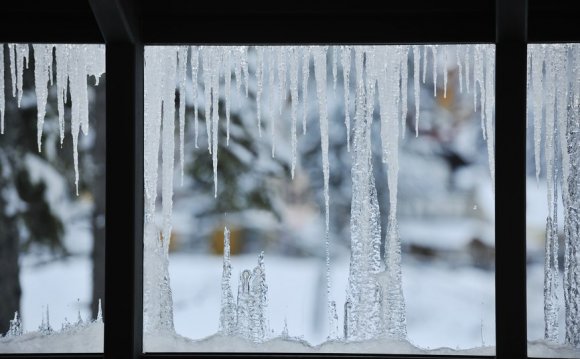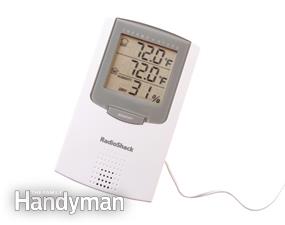

Close-up of a hydrometer
A hygrometer monitors indoor relative humidity so you can track moisture changes.
Some homes have a problem with windows sweating on the inside during the winter, whenever the temperature drops to about 40 degrees F. Even the frames and the sills become wet. This even happens on newer homes that are well insulated. If you have this problem, the humidity level in your home is probably a bit too high. With double-pane windows, you should be able to sustain somewhere around 50 to 55 percent relative humidity indoors on a 40-degree night and not get condensation on your windows. That means that if the relative humidity in your home is higher, say 60 or 70 percent, your windows will become dehumidifiers and condense water from the air until the relative humidity level inside drops to the 55 percent range.
Newer homes are typically built much more tightly than older ones. This is good for many reasons, but one bad side effect is that moisture generated indoors doesn't escape as easily. There are a number of potential solutions, but before you try one, I'd recommend that you buy an inexpensive hygrometer to monitor your indoor relative humidity. This will allow you to track the problem and watch the effects of changes.
Gas and propane release a lot of moisture when they burn, so the fireplace will increase the moisture level in your home if you use it extensively. Watch your hygrometer to see if running the fireplace causes a significant increase in indoor relative humidity.
It's also possible that your new home is still drying out: New concrete, wood and other materials usually take 12 to 18 months to dry, depending on drying conditions. You can't control this, but on cold evenings you can open your doors and flush the warm humid air out of your home for 10 to 15 minutes.
Again, once the indoor temperature returns to normal, your hygrometer should tell you that the relative humidity has dropped, and the problem may disappear after another heating season. Sometimes this problem occurs only at the beginning of the heating season, when materials are drying out after a humid summer, and disappears after a few weeks.
If neither of these seems to be the problem, look for other sources of excess moisture. Some common sources, like lots of green plants, can be easily controlled. But other common ones can't, like ground moisture moving up through the concrete slab. If you can't diagnose the problem, talk with your local building inspector about the moisture problems common to your area. Or call in a home inspector who understands condensation (and mold) issues for a home inspection and diagnosis.









